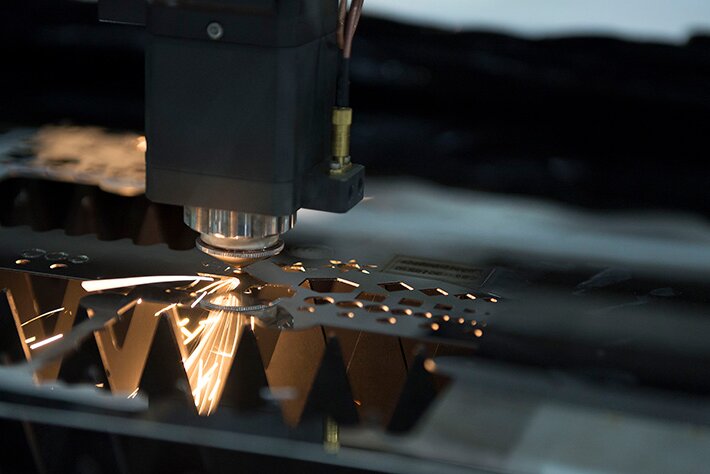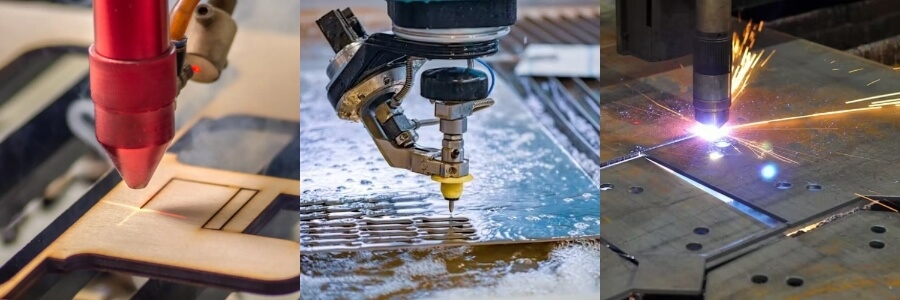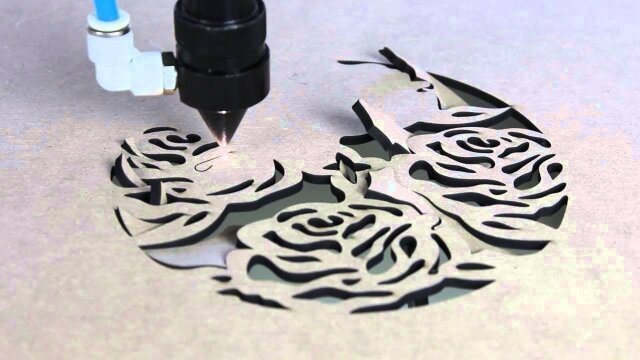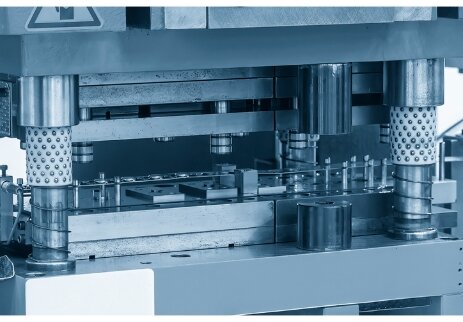غالباً ما يعاني المهندسون والمصممون في اختيار عملية تشكيل المعادن المناسبة التي توازن بين الدقة والمتانة والجدوى الاقتصادية. يبرز ختم النحاس كحل يغير قواعد اللعبة، مما يسمح للمصنعين بتحويل المواد الخام إلى مكونات معقدة وعالية الأداء بكفاءة ملحوظة.
تهدف هذه المدونة إلى توضيح تعقيدات ختم النحاس وجعلها في متناول المهندسين والمصممين والمصنعين على حد سواء.
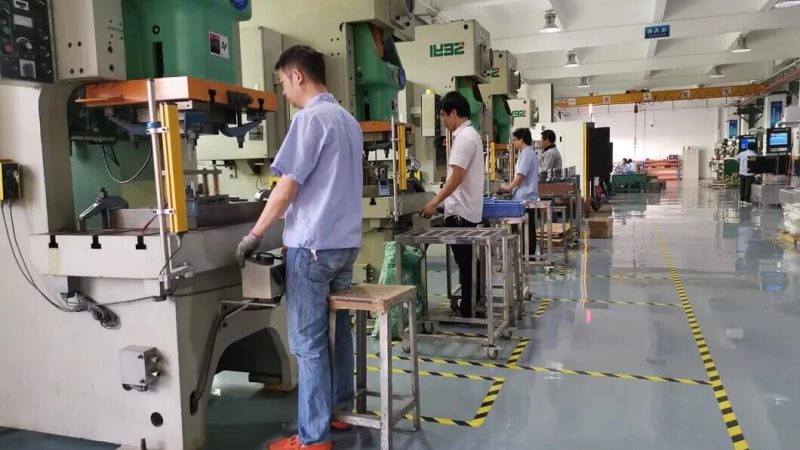
أساسيات ختم النحاس
ختم النحاس هو عملية تصنيع تنطوي على تشكيل صفائح النحاس في أشكال محددة باستخدام مكبس ختم مزود بقوالب. يمكن أن يؤدي فهم أساسيات ختم النحاس إلى تعزيز قدرتك على تصميم وتصنيع المكونات العملية بشكل كبير.
ما هو ختم النحاس؟
ختم النحاس هو تقنية تصنيع تقوم بتحويل الصفائح المسطحة من النحاس إلى أشكال وتصميمات معقدة. تتضمن العملية عادةً مكبس ختم مزود بقالب يطبق قوة كبيرة لتشكيل المعدن. تُستخدم هذه الطريقة على نطاق واسع في مختلف الصناعات نظراً لما يتميز به النحاس من توصيل ممتاز ومرونة ومقاومة للتآكل.
خواص النحاس ذات الصلة بالختم
يمتلك النحاس العديد من الخصائص الأساسية التي تجعله مناسبًا بشكل خاص لتطبيقات الختم:
- توصيل كهربائي وحراري ممتاز: يشتهر النحاس بتوصيله الفائق، وهو أمر ضروري للمكونات الكهربائية.
- تطويع: يمكن تشكيل النحاس بسهولة دون أن ينكسر، مما يسمح للمصنعين بإنشاء تصميمات معقدة.
- المقاومة للتآكل: يطور النحاس بشكل طبيعي طبقة أكسيد واقية تعزز مقاومته للتآكل.
- ليونة: إن قدرة النحاس على الخضوع لتشوه كبير دون حدوث كسر تمكنه من تحمل ضغوط عملية الختم.
اختيار المادة النحاسية المناسبة لمشروعك
يتضمن اختيار المادة النحاسية المناسبة لمشروع الختم الخاص بك النظر في عدة عوامل:
- متطلبات التقديم: قم بتقييم ما إذا كان مشروعك يعطي الأولوية للتوصيل الكهربائي أو القوة أو مقاومة التآكل.
- الظروف البيئية: ضع في اعتبارك بيئة التشغيل. إذا كانت المكونات ستتعرض للرطوبة أو المواد الكيميائية، فقد يكون من المفيد استخدام سبيكة مقاومة للتآكل.
- عمليات التصنيع: تقييم كيفية أداء المادة المختارة أثناء الختم والعمليات اللاحقة مثل اللحام أو لحام.
تقنيات ختم النحاس
يشمل ختم النحاس تقنيات مختلفة مصممة خصيصًا لتلبية احتياجات الإنتاج ومتطلبات التصميم المحددة. نستكشف هنا أربع تقنيات ختم أساسية مستخدمة في تصنيع النحاس.
ختم القالب التقدمي
ختم القالب التدريجي هي طريقة عالية الكفاءة تستخدم سلسلة من القوالب لإجراء عمليات متعددة على شريط مستمر من النحاس. أثناء تحرك الشريط المعدني عبر الماكينة، تقوم كل محطة قالب بتنفيذ مهمة محددة - القطع أو الثني أو التشكيل - حتى اكتمال الجزء النهائي.
ختم السحب العميق
ختم السحب العميق هي تقنية لإنشاء أشكال عميقة مجوّفة من صفائح النحاس المسطحة. وتتضمن هذه العملية سحب المعدن إلى تجويف قالب باستخدام مثقاب، والذي يقوم بتمديد المادة وتشكيلها بالشكل المطلوب.
النقش والنقش على العملات المعدنية
إن النقش والنقش هما تقنيتا ختم تخلقان تصاميم بارزة أو غائرة على الأسطح النحاسية. ينطوي النقش على استخدام ضغط عالٍ لتشكيل أشكال أو أنماط دقيقة، في حين أن النقش يخلق تصاميم بارزة عن طريق دفع المواد من خلف الصفيحة.
التقطيع الدقيق للأجزاء الدقيقة
الطمس الدقيق هي عملية ختم متخصصة تنتج قطعًا ذات تفاوتات ضيقة للغاية وحواف ناعمة. تتضمن هذه التقنية استخدام مكبس ختم يطبق قوة كبيرة لقص المعدن بشكل نظيف دون تشويه.
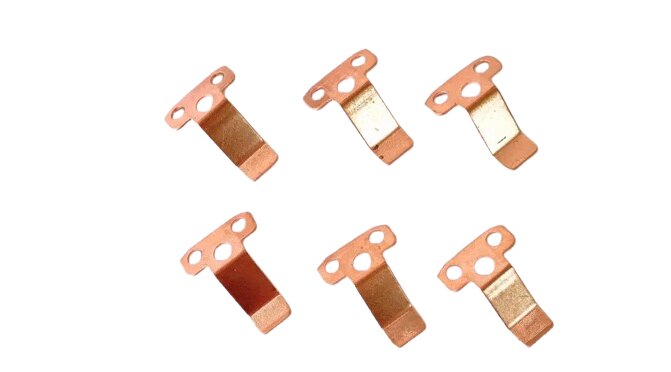
كيفية ختم النحاس: دليل خطوة بخطوة
يحول ختم النحاس المواد الخام إلى مكونات دقيقة من خلال خطوات تصنيع مخططة بدقة. تتطلب كل مرحلة خبرة فنية ومعدات متطورة واهتماماً دقيقاً بالتفاصيل.
اختيار المواد وإعدادها
يفحص الفنيون بعناية سُمك المواد وجودة السطح والخصائص المعدنية. ويقومون بتنظيف وتسطيح الصفائح النحاسية وإزالة الملوثات السطحية التي قد تؤثر على دقة الختم.
مراحل عملية الختم
تتضمن عملية الختم مراحل حرجة متعددة. تستخدم المكابس الميكانيكية قوة محكومة لتشويه صفائح النحاس باستخدام قوالب مصممة بدقة. وغالباً ما تتطلب المكونات المعقدة دورات ختم متعددة، مع تلدين وسيط للحفاظ على ليونة المواد ومنع تصلب العمل.
مراقبة الجودة والتفتيش
تضمن الإجراءات الصارمة لمراقبة الجودة أن كل مكوّن مختوم يفي بالمواصفات الدقيقة. يستخدم الفنيون معدات قياس متقدمة، مثل ماكينات قياس الإحداثيات (CMM)، للتحقق من دقة الأبعاد.
أدوات ختم النحاس
تُعد الأدوات جانبًا مهمًا في عملية ختم النحاس، حيث إنها تؤثر بشكل مباشر على جودة وكفاءة الإنتاج. يغطي هذا القسم اعتبارات تصميم قوالب ختم النحاس والمواد المستخدمة عادةً في أدوات الختم.
اعتبارات التصميم الخاصة بقوالب ختم النحاس
عند تصميم القوالب لختم النحاس، يجب مراعاة عدة عوامل رئيسية لتحسين الأداء وطول العمر:
- هندسة القالب: يجب أن يتطابق شكل القالب وتكوينه مع التصميم المقصود للجزء المختوم.
- التخليص: يعد الخلوص الكافي بين القالب والخرامة أمرًا بالغ الأهمية لمنع الاحتكاك المفرط، والذي يمكن أن يؤدي إلى التآكل أو التلف.
- اختيار المواد: يجب أن تتحمل مواد القوالب الضغوط العالية وتقاوم التآكل مع الحفاظ على دقة الأبعاد طوال عمرها الافتراضي.
- سهولة الصيانة: يمكن أن يسهل تصميم القوالب مع وضع الصيانة في الاعتبار إجراء إصلاحات أو تعديلات أسرع.
المواد المستخدمة في أدوات الختم
يعد اختيار المواد المستخدمة في أدوات الختم أمرًا بالغ الأهمية لتحقيق خصائص الأداء المطلوبة. وتشمل المواد الشائعة المستخدمة في بناء قوالب الختم ما يلي:
- أداة الصلب: كثيرًا ما يتم استخدام الفولاذ عالي الكربون وسبائك الفولاذ المصنوع من الفولاذ عالي الكربون بسبب صلابته الممتازة ومقاومته للتآكل وقدرته على الاحتفاظ بالحواف الحادة.
- الكربيد الأسمنتي: يُعرف بصلابته الاستثنائية ومقاومته للتآكل، وغالبًا ما يُستخدم في التطبيقات عالية الأداء حيث تكون المتانة أمرًا بالغ الأهمية.
- الكربيد الأسمنتي المربوط بالصلب: تجمع هذه المادة بين صلابة الفولاذ وصلابة الكربيد الأسمنتي، مما يجعلها مناسبة للتطبيقات التي تتطلب قوة ومقاومة للتآكل.
- برونز الألومنيوم: بالنسبة للتطبيقات التي تشتمل على معادن غير حديدية مثل النحاس، يمكن استخدام برونز الألومنيوم كمادة قالب نظرًا لخصائصه الجيدة المضادة للالتصاق.
- مواد البوليمر: في بعض الحالات، يتم استخدام المواد القائمة على البوليمر لتطبيقات محددة حيث تكون مقاومة التآكل المنخفضة مقبولة ولكن المطلوب توفير الوزن.
ختم النحاس: الإيجابيات والسلبيات
ختم النحاس هو عملية تصنيع مستخدمة على نطاق واسع تقدم العديد من المزايا ولكن لها أيضًا بعض العيوب. يمكن أن يساعد فهم هذه المزايا والعيوب المصنعين على تحديد ما إذا كان ختم النحاس يناسب مشاريعهم.
الايجابيات
- توصيل كهربائي ممتاز: يشتهر النحاس بموصلية كهربائية فائقة، مما يجعله خيارًا مثاليًا للتطبيقات في مجال الإلكترونيات والسيارات والأنظمة الكهربائية.
- المقاومة للتآكل: تطيل قدرة النحاس الطبيعية على مقاومة التآكل من عمر الأجزاء المختومة.
- القابلية للطرق والليونة: يمكن تشكيل النحاس وتشكيله بسهولة في تصميمات معقدة دون أن ينكسر.
- النداء الجمالي: يضيف اللون الدافئ واللمعان الطبيعي للنحاس قيمة جمالية مميزة للمنتجات.
سلبيات
- ارتفاع تكاليف الأدوات الأولية: يمكن أن يكون إنتاج القوالب والأدوات المخصصة لختم النحاس مكلفًا.
- ملاءمة محدودة للدفعات الصغيرة: التكاليف المرتبطة بالأدوات قد تفوق الفوائد بالنسبة للدفعات الصغيرة أو الإنتاج من قطعة واحدة.
- حدود الدقة: على الرغم من أن ختم النحاس يسمح بتصميمات معقدة، إلا أن تحقيق تفاوتات ضيقة للغاية قد يكون أمراً صعباً.
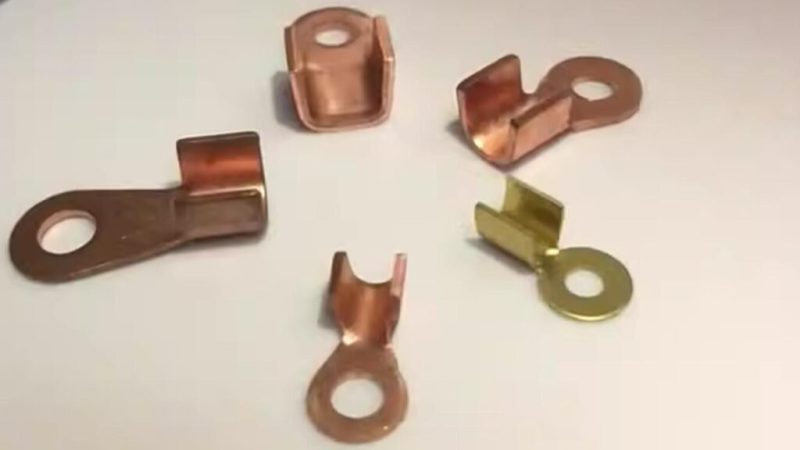
تطبيقات ختم النحاس
ختم النحاس هو عملية تصنيع متعددة الاستخدامات تُستخدم في مجموعة واسعة من الصناعات. نلقي نظرة هنا على التطبيقات الهامة لختم النحاس في مجالات مختلفة.
صناعة الإلكترونيات والكهرباء
في صناعة الإلكترونيات والصناعات الكهربائية، يعد ختم النحاس أمرًا بالغ الأهمية في إنتاج المكونات التي تتطلب توصيلًا كهربائيًا وموثوقية عالية. وتشمل التطبيقات الشائعة ما يلي:
- الموصلات والمحطات الطرفية
- المشتتات الحرارية
- مفاتيح التبديل والمرحلات
- لوحات الدوائر الكهربائية
تطبيقات السيارات والفضاء الجوي
يُعد ختم النحاس أيضًا جزءًا لا يتجزأ من صناعات السيارات والفضاء، حيث يتم استخدامه لتصنيع المكونات التي يجب أن تتحمل الظروف الصعبة. وتشمل التطبيقات الرئيسية ما يلي:
- الأنظمة الكهربائية
- الموصلات والأسلاك
- المبادلات الحرارية
- مكونات الفضاء الجوي
السلع الصناعية والاستهلاكية
يُستخدم ختم النحاس على نطاق واسع في إنتاج المكونات الصناعية وكذلك السلع الاستهلاكية. وتشمل التطبيقات البارزة ما يلي:
- تركيبات السباكة
- الملامح المعمارية
- أجهزة طبية
- مستهلكى الكترونيات
خاتمة
يمثّل ختم النحاس ذروة تكنولوجيا التصنيع الحديثة، حيث يربط بين التصميم المبتكر والتنفيذ الهندسي الدقيق. تعمل هذه العملية المتطورة على تحويل المواد النحاسية الخام إلى مكونات عالية الأداء، مما يدفع عجلة التقدم التكنولوجي في العديد من الصناعات.
مهلا، أنا كيفن لي

على مدى السنوات العشر الماضية، كنت منغمسًا في أشكال مختلفة من تصنيع الصفائح المعدنية، وشاركت رؤى رائعة هنا من تجاربي عبر ورش العمل المتنوعة.
ابقى على تواصل

كيفن لي
لدي أكثر من عشر سنوات من الخبرة المهنية في تصنيع الصفائح المعدنية، وتخصصت في القطع بالليزر، والثني، واللحام، وتقنيات معالجة الأسطح. كمدير فني في شنغن، أنا ملتزم بحل تحديات التصنيع المعقدة ودفع الابتكار والجودة في كل مشروع.

